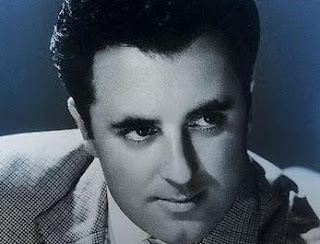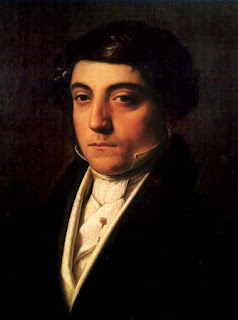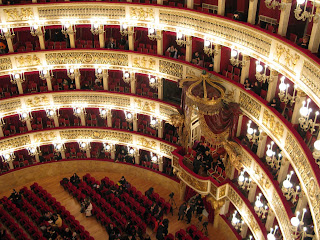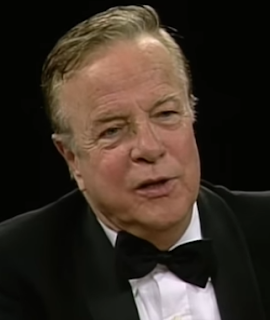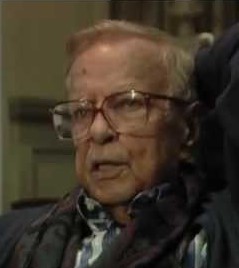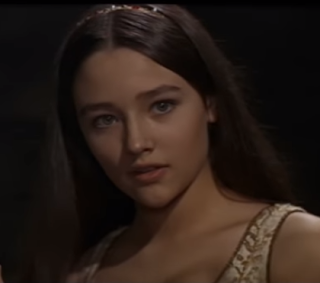Rossini’s first professional work premieres in Venice
 |
| The title page of the libretto for the opera, by Gaetano Rossi |
Although the Pesaro-born composer, who would go on to write 39 operas including Il barbiere di Siviglia (The Barber of Seville) and La Cenerentola (Cinderella), had tried his hand at the genre earlier, La cambiale di matrimonio was the first to be staged in public.
Rossini had written the one-act farce - translated in English as The Bill of Marriage or The Marriage Contract - in the space of just a few days while he was an 18-year-old student at the Liceo Musicale in Bologna.
Based on a play of the same name by Camillo Federici, an 18th century dramatist from Piedmont, La cambiale di matrimonio revolves around the attempts by a London merchant, Tobias Mill, to marry off his daughter, Fanny, to a somewhat mature Canadian businessman by the name of Slook.
Mill makes this arrangement, which is designed primarily for his own financial gain, without knowing that Fanny has a lover, Edward Milfort, whose existence she has kept secret from her father on account of his lowly financial status.
The action takes place in the drawing room of the Mill house, where Edward and Fanny are together at just the moment Slook arrives.
La cambiale di matrimonio had a brief run, lasting just 13 performances, but the presence of a well-regarded mezzo-soprano, Rosa Morandi, in the role of Fanny attracted attention and the two baritones cast as Mill and Crook are said to have played to the gallery as the composer intended.
 |
| The young Rossini wrote a series of farces for the Teatro San Moisè |
The Teatro San Moisè, meanwhile, invited the young Rossini to compose more works along the same lines. He obliged by delivering three more farces, L'inganno felice (The Fortunate Deception), La scala di seta (The Silken Ladder) and Il signor Bruschino.
Active from 1620 to 1818, the Teatro San Moisè, which could be found near the start of the Grand Canal and just a few steps from Piazza San Marco, was a small theatre but an influential one.
Its first opera production was Claudio Monteverdi's L'Arianna in 1640, while in the 18th century the music of the Baroque composers Francesco Gasparini, Antonio Vivaldi and Tomaso Albinoni was frequently performed there.
When the Neapolitan opera buffa genre arrived in Venice in the 1740s, San Moisè became something of a showcase for the genre, staging works by Baldassare Galuppi, who formed a partnership with the brilliant playwright and librettist, Carlo Goldoni.
The theatre closed in 1818 and was later revived as a puppet theatre and a cinema but the building was demolished in the 20th century.
.jpg) |
| The church of San Moisè contains works by Tintoretto and Palma il Giovane |
The church of San Moisè, from which the theatre took its name, can be found just 124m (135 yards) from Piazza San Marco in Campo San Moisè, flanked on one side by the modern, five-star Hotel Bauer and on the other by the Venice stores of Versace and Prada. Built originally in the eighth century, the church’s elaborately decorated Baroque facade was added in the late 17th century to a design by the Padua architect Alessandro Tremignon. The interior is dominated by Heinrich Meyring's huge altarpiece, depicting Moses at Mount Sinai receiving the Tablets. The Old Testament prophets were considered by the Venetians as saints. Also inside are a Washing of the Feet by Tintoretto and a Last Supper by Palma il Giovane.
 |
| The Ducal Palace in Pesaro was commissioned by ruler Alessandro Sforza in the 15th century |
Pesaro, while a major centre for tourism due to its location on the Adriatic coast, is also a former mediaeval city of some standing, ruled by Giovanni Sforza between 1483 and 1510. It had a 15th century Ducal Palace, commissioned by Alessandro Sforza, one of Giovanni’s ancestors, and an imposing castle, the Rocca Costanza, built by Costanza I Sforza, the condottiero who was Alessandro’s son. Today, it is known as the city of music. Each summer, in honour of Gioachino Rossini, born in 1792, it hosts the Rossini Opera Festival, and the town is home to the Conservatorio Statale di Musica Gioachino Rossini, which was founded from a legacy left by the composer.
Also on this day:
1560: The birth of painter Annibale Carracci
1801: The birth of composer Vincenzo Bellini
1908: The birth of politician Giovanni Leone
1918: The Villa Giusti Armistice
1931: The birth of actress Monica Vitti
